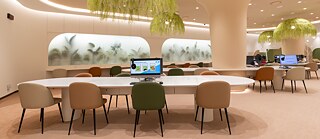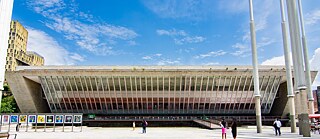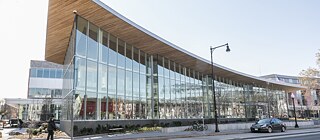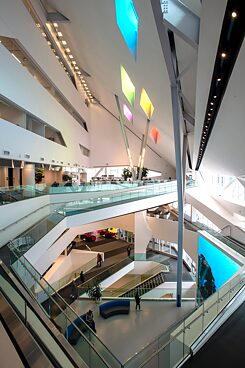Green Libraries Sustainable, Social, Visionary

Education for Sustainability is no longer just a theoretical approach in libraries. Increasing numbers of public libraries worldwide are leading by example: they are rethinking their concept, demonstrating commitment to social cohesion and illustrating what environmentally friendly architecture might look like in the future.
Biblioteca EPM in the north-west of Columbia has installed an incredible 450 solar panels to generate its own renewable energy. With these, the library can meet over one-third of its energy requirements: the site covers more than 10,000 square metres and comprises a reading room, internet spaces, an exhibition gallery, café, classrooms, children’s areas, a film library, lecture theatres and study corners.
But it’s not just architecture – sustainability is a central focus in many other capacities at this library in central Medellín. The EPM Library also embraces Education for Sustainable Development in terms of content. This is reflected in its media collection relating to the priority areas of science, industry, environment and technology, as well as the events and courses offered. There’s a children’s reading club aligned with United Nations sustainability goals, an integrative robotics workshop, a story contest entitled “My sustainable future”, and even an educational garden.
It received the “Best Green Library” award 2023 for its commitment. Libraries from all over the world compete for the annual award, which is conferred by the International Federation of Library Associations and Institutions (IFLA).

Biblioteca EPM in the north-west of Columbia covers more than 10,000 square metres and comprises a reading room, internet spaces, an exhibition gallery, café, classrooms, children’s areas, a film library, lecture theatres and study corners.
A Green Oasis in the Shopping Centre
“(Re)Connect with Nature” – that’s the theme of the public library in the Choa Chu Kang district in the north-east of the Asian city state of Singapore. The library’s location might seem surprising at first glance: it is spread across two floors of a shopping centre.
But as soon as visitors enter the library, which reopened in 2021 after a two-year revamp, they are transported into a green oasis. In the “Green Grove” for instance, edible herbs and vegetables are bred and cultivated in a hydroponic system. An Augmented Reality learning trail brings flora and fauna to life. And the Community Wall provides information about the agricultural heritage of the region, which is surrounded by fruit plantations, as well as the methods of modern farming.
The library with its indoor garden is the first in its country to take up the cause of sustainability. The institution, the interior of which is largely built with sustainable materials, won the 2022 IFLA Green Library Award.
A Meeting Point for Everyone
The Valente Branch Library is part of a community complex in the heart of Cambridge, a city in the US state of Massachusetts. The community meeting point incorporates a school, a pre-school, an open-air swimming pool and an administration building.
The Valente Branch Library itself is set up as a meeting point. The building is designed to let in plenty of natural light and the library programme is centred around inclusion and equality. As part of the Cambridge Library Network, the Valente branch runs workshops on activities that save energy and resources, such as sewing and repairs. Furthermore it provides health services for the elderly in particular, supports job-seekers, offers English courses and one-to-one tutoring, and donates technical equipment to disadvantaged groups.
The complex to which the library belongs was opened in 2019 and is part of the city’s ambitious intention to become climate-neutral by 2040: at the time of construction, the architectural goal was for it to be a Net Zero Emissions building. The group of buildings meets around 60 per cent of its own energy needs – for example with the PV array installed on roofs and façades. Heating is from a geothermal energy source; rainwater is used to flush the toilet and irrigate the surrounding green areas.

The Valente Branch Library is designed to be a meeting point. The building is designed to let in plenty of natural light and the library programme is centred around inclusion and equality.
Green Literature and Insect Hotels
A place where all aspects of sustainability are addressed, studied and discussed is the Illyés Gyula Library in the county of Tolna, Hungary. Along with green literature, a key focus here is social responsibility.
The library programme includes features such as recycling campaigns, a flower seed exchange to encourage biodiversity, organised walks, workgroups for young people with disabilities, and donations to the local animal shelter and children’s hospital. The library maintains a feeding station for bats and provides insect hotels. It is also the initiator of a nationwide network of green libraries and cooperates closely with local, national and international organisations.
Old Building, New Design
 Turning old into new – and sustainable: When the Stanley A. Milner Library in the city of Edmonton was renovated, around 90 per cent of the building waste was recycled.
Turning old into new – and sustainable: the Stanley A. Milner Library in the city of Edmonton in the Canadian state of Alberta is an outstanding example of how existing structural fabric can be upgraded and buildings revitalised.
Turning old into new – and sustainable: When the Stanley A. Milner Library in the city of Edmonton was renovated, around 90 per cent of the building waste was recycled.
Turning old into new – and sustainable: the Stanley A. Milner Library in the city of Edmonton in the Canadian state of Alberta is an outstanding example of how existing structural fabric can be upgraded and buildings revitalised.
When the facility dating from 1967 fell into disrepair, it underwent extensive renovation. The resulting learning and gathering space meets the criteria of LEED (Leadership in Energy and Environmental Design), an internationally recognised certification system for environmentally friendly construction. Around 90 per cent of the building waste was recycled and only materials from an 800-kilometre radius were used. The architecture concept prioritised dynamics, transparency and openness.
The library, which reopened in 2020, is now home to North America’s largest interactive digital wall and a gamer space, it offers courses in 3D printing and charging points for electric cars, and also has good public transport links, footpaths and cycle routes. In 2021 the library won first prize in the IFLA Awards for its design.


